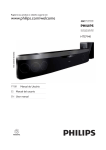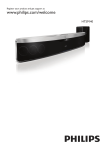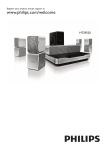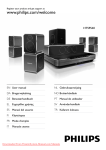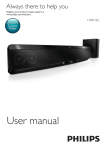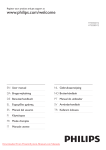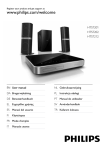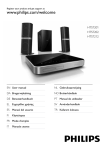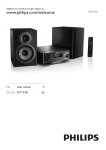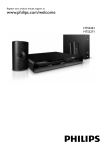Download Philips HTS7140
Transcript
Registre seu produto e obtenha suporte em www.philips.com/welcome HTS7140 1 Important Safety Product care Disposal of your old product and batteries 3D health warning 2 Your home theater Main unit Remote control 3 Connect your home theater Connectors Connect to the TV Connect audio from TV or other devices Connect to the Internet 4 Use your home theater Before you start Access the home menu Choose your sound Play a disc Use Bonus View on Blu-ray Access BD-Live on Blu-ray Play 3D video Play from a USB storage device More play features for disc or USB Browse Net TV Play from radio Play audio from TV or other devices Play from an MP3 player Play from an iPod or iPhone Use Philips EasyLink 5 Change settings Access the setup menu Change video settings Change audio settings Set up network Set up EasyLink Change preference settings Change advanced settings 2 2 2 3 3 4 4 4 Update software Check software version Update software from the network Update software from a USB Update electronic user manual 21 21 21 22 22 7 Product specications 23 8 Troubleshooting 24 9 Index 26 7 7 8 9 10 11 11 11 11 12 13 13 14 14 14 15 16 17 17 17 17 18 18 18 19 19 19 20 20 EN 1 Eng l i s h 6 Contents 1 Important Read and understand all instructions before you use your home theater. If damage is caused by failure to follow instructions, the warranty does not apply. Safety Risk of electric shock or re! • Never expose the product and accessories to rain or water. Never place liquid containers, such as vases, near the product. If liquids are spilt on or into the product, disconnect it from the power outlet immediately. Contact Philips Consumer Care to have the product checked before use. • Never place the product and accessories near naked flames or other heat sources, including direct sunlight. • Never insert objects into the ventilation slots or other openings on the product. • Where the mains plug or an appliance coupler is used as the disconnect device, the disconnect device shall remain readily operable. • Disconnect the product from the power outlet before lightning storms. • When you disconnect the power cord, always pull the plug, never the cable. Risk of short circuit or re! • Before you connect the product to the power outlet, ensure that the power voltage matches the value printed on the back or bottom of the product. Never connect the product to the power outlet if the voltage is different. Risk of injury or damage to the home theater! • For wall-mountable products, use only the supplied wall mount bracket. Secure the wall mount to a wall that can support the combined weight of the product and the wall mount. Koninklijke Philips Electronics N.V. bears no responsibility for improper wall mounting that results in accident, injury or damage. 2 EN • For speakers with stands, use only the supplied stands. Secure the stands to the speakers tightly. Place the assembled stands on flat, level surfaces that can support the combined weight of the speaker and stand. • Never place the product or any objects on power cords or on other electrical equipment. • If the product is transported in temperatures below 5°C, unpack the product and wait until its temperature matches room temperature before connecting it to the power outlet. • Visible and invisible laser radiation when open. Avoid exposure to beam. • Do not touch the disc optical lens inside the disc compartment. Risk of overheating! • Never install this product in a confined space. Always leave a space of at least four inches around the product for ventilation. Ensure curtains or other objects never cover the ventilation slots on the product. Risk of contamination! • Do not mix batteries (old and new or carbon and alkaline, etc.). • Remove batteries if they are exhausted or if the remote control is not to be used for a long time. • Batteries contain chemical substances, they should be disposed of properly. Product care • • • • Do not insert any objects other than discs into the disc compartment. Do not insert warped or cracked discs into the disc compartment. Remove discs from the disc compartment if you are not using the product for an extended period of time. Only use microfiber cloth to clean the product. Your product is designed and manufactured with high quality materials and components, which can be recycled and reused. When this crossed-out wheeled bin symbol is attached to a product it means that the product is covered by the European Directive 2002/96/ EC. Please inform yourself about the local separate collection system for electrical and electronic products. Please act according to your local rules and do not dispose of your old products with your normal household waste. Correct disposal of your old product helps to prevent potential negative consequences for the environment and human health. 3D health warning If you or your family has a history of epilepsy or photosensitive seizures, consult a medical professional before exposing yourself to flashing light sources, rapid image sequences or 3D viewing. To avoid discomfort such as dizziness, headache or disorientation, we recommend not watching 3D for extended periods of time. If you experience any discomfort, stop watching 3D and do not immediately engage in any potentially hazardous activity (for example driving a car) until your symptoms have disappeared. If symptoms persist, do not resume watching 3D without consulting a medical professional first. Parents should monitor their children during 3D viewing and ensure they do not experience any discomfort as mentioned above. Watching 3D is not recommended for children under six years of age as their visual system is not fully developed yet. Your product contains batteries covered by the European Directive 2006/66/EC, which cannot be disposed with normal household waste. Please inform yourself about the local rules on separate collection of batteries because correct disposal helps to prevent negative consequences for the environmental and human health. EN 3 Eng l i s h Disposal of your old product and batteries 2 Your home theater Congratulations on your purchase, and welcome to Philips! To fully benefit from the support that Philips offers, register your home theater at www. philips.com/welcome. Main unit Remote control Note • Your home theater is supplied with one of the following remote controls. Remote control - A 1 19 2 18 a +/- ( Volume) Increases or decreases volume. b SOURCE Selects a media to play or an audio input source. c (Standby-On) Switches on the home theater or switches to standby mode. d Playback buttons 5 17 (Eject) Ejects the disc from the disc compartment. 6 16 15 Control playback. e 3 4 7 8 9 10 14 f Display panel g Disc compartment 11 13 4 EN 12 (Standby-On) Switches the home theater on or to standby. • When EasyLink is enabled, press and hold for at least three seconds to switch all connected HDMI CEC compliant devices to standby. o • b (Home) Accesses the home menu. c SOUND SETTINGS Accesses or exits various sound OPTIONS. d Navigation buttons • Navigates menus. • In radio mode, press left or right to start auto search. e OK • Confirms an entry or selection. f OPTIONS • Accesses more play OPTIONS during playback. • In radio mode, programs radio stations. (Stop) / (Eject / Open/Close) Stops play. Press and hold to eject the disc or open the disc compartment. • In radio mode, erases the current preset radio station. • • p (Mute) Mutes or restores volume. q BACK Returns to a previous menu screen. Eng l i s h a r POP-UP MENU/DISC MENU Accesses or exits the disc menu. s Source buttons • Color buttons (for Blu-ray discs): • • • • Selects tasks or OPTIONS. DISC: Switches to disc source. RADIO: Switches to FM radio. DOCK for iPod: Switches to Philips Dock for iPod/iPhone. SOURCE : Selects an audio input source. g +/- ( Volume) Increases or decreases volume. h (Play) Starts or resumes play. i (Pause) Pauses play. j / (Fast Backward/Fast Forward) Fast backwards or fast forwards. Press repeatedly to change the search speed. k Alphanumeric buttons Enters values or letters (using SMS style entry). l SUBTITLE Selects subtitle language for video. m TOP MENU Accesses the main menu of a video disc. n / • • (Previous/Next) Skips to the previous or next track, chapter or file. In radio mode, selects a preset radio station. EN 5 Remote control - B b (Home) Accesses the home menu. c (Disc menu) Accesses or exits the disc menu. 2 d Navigation buttons • Navigates menus. • In radio mode, press left or right to 3 e 1 start auto search. 4 5 / • • 5 6 18 7 8 9 f OK Confirms an entry or selection. g h (OPTIONS) Accesses more play OPTIONS during playback. • In radio mode, programs radio stations. 10 11 i 12 j +/- ( Volume) 13 14 (Play) Starts or resumes play. Increases or decreases volume. k 15 (Sound OPTIONS) Accesses or exits various sound OPTIONS. • 17 16 (Pause) Pauses play. l Source buttons / Color buttons • Blu-ray discs: Selects tasks or OPTIONS. • AUDIO SOURCE : Selects an audio • • • a 6 (Previous/Next) Skips to the previous or next track, chapter or file. In radio mode, selects a preset radio station. input source. DOCK for iPod: Switches to Philips Dock for iPod/iPhone. RADIO: Switches to FM radio. DISC: Switches to disc source. m Alphanumeric buttons (Standby-On) • Switches the home theater on or to standby. • When EasyLink is enabled, press and hold for at least three seconds to switch all connected HDMI CEC compliant devices to standby. EN Enters values or letters (using SMS style entry). n TOP MENU Accesses the main menu of a video disc. o SUBTITLE Selects subtitle language for video. (Stop) Stops play. Press and hold to eject the disc or open the disc compartment. • In radio mode, erases the current preset radio station. • • q / (Fast Backward/Fast Forward) Fast backwards or fast forwards. Press repeatedly to change the search speed. r (Back) Returns to a previous menu screen. 3 Connect your home theater This section helps you connect your home theater to a TV and other devices. The basic connections of the home theater with its accessories are provided in the Quick Start. For a comprehensive interactive guide, see www.connectivityguide.philips.com. Note • Refer to the type plate at the back or bottom of the product for identification and supply ratings. • Before you make or change any connections, ensure that all devices are disconnected from the power outlet. Connectors Connect other devices to your home theater. Side connectors a MP3 LINK Audio input from an MP3 player. b (USB) Audio, video or picture input from a USB storage device. EN 7 Eng l i s h p Back connectors Connect to the TV Connect your home theater directly to a TV through one of the following connectors (from highest to basic quality video): a HDMI b Component video c Composite video a LAN Connects to the LAN input on a broadband modem or router. b AC MAINS~ Connects to the power supply. c HDMI OUT (ARC) Connects to the HDMI input on the TV. d VIDEO OUT Connects to the composite video input on the TV. e COMPONENT VIDEO OUT Connects to the component video input on the TV. Option 1: Connect to the TV through HDMI Note • The HDMI connector on the TV might be labeled HDMI IN or HDMI ARC . • If the TV supports HDMI Audio Return Channel (ARC), you can use it to output digital audio to the home theater. • If the HDTV has a DVI connector, connect using an HDMI/DVI adapter. • If the TV supports EasyLink HDMI CEC, control the home theater and TV with one remote control (see ‘Use Philips EasyLink’ on page 17 ). f SUBWOOFER Connects to the supplied subwoofer. g AUDIO IN - AUX Connects to the analog audio output on the TV or an analog device. TV h DOCK for iPod Connects to a Philips Dock for iPod/iPhone. (Model: Philips DCK3060, sold separately) i DIGITAL IN - OPTICAL Connects to the optical audio output on the TV or a digital device. j ANTENNA FM (75 ) Signal input from an antenna, cable or satellite. k DIGITAL IN-COAXIAL Connects to the coaxial audio output on the TV or a digital device. 8 EN Option 2: Connect to the TV through YPbPr (component video) Note • The component video cable or connector might be labeled Y Cb Cr or YUV. (Cable not supplied) Component Video Out Eng l i s h Option 1: Connect audio through analog audio cables (Cable not supplied) TV Component Video In TV Option 3: Connect to the TV through composite video (CVBS) Note • The composite video cable or connector might be labeled AV IN , VIDEO IN , COMPOSITE or BASEBAND. (Cable not supplied) TV Option 2: Connect audio through coaxial cable Note • The digital coaxial cable or connector might be labeled COAXIAL/DIGITAL OUT or SPDIF OUT. Connect audio from TV or other devices Use your home theater to play audio from the TV or other devices such as a cable box. (Cable not supplied) TV Tip • Press SOURCE / AUDIO SOURCE repeatedly to select the audio output of your connection. EN 9 Option 3: Connect audio through a digital optical cable (Cable not supplied) LAN Note • The digital optical cable or connector might be labeled as SPDIF OUT or OPTICAL OUT. (Cable not supplied) TV www Connect to the Internet Connect the home theater to the internet and enjoy: • BD-Live: You can access BD-Live features (see ‘Access BD-Live on Bluray’ on page 13). • Net TV : browse Net TV services (see ‘Browse Net TV’ on page 15). • Software update: You can update the software of the home theater through the network (see ‘Update software from the network’ on page 21). What you need: • A network router (with DHCP enabled). • A network cable (RJ45 straight cable). • For Net TV and software update, make sure that the network router has access to the Internet and is not restricted by firewalls or other security systems. Note • Net TV feature only available in Latin America. 10 EN Set up network 1 2 3 4 5 6 7 8 9 Connect the home theater to a broadband modem or router (see ‘Connect to the Internet’ on page 10). Turn on your TV and switch to the correct source for the home theater. Press (Home). Select [Setup], then press OK . Select [Network] > [Network Installation], then press OK . Select [Wired (Ethernet)], then press OK . Select [Auto (recommended)] or [Manual (advanced)], then press OK . Follow the instructions on the TV to complete the setup. » The home theater connects to the internet. If connection fails, select [Retry], then press OK. Select [Finish], then press OK to exit. Use your home theater This section helps you use the home theater to play media from a wide range of sources. Before you start Check that you: • Make the necessary connections described in the Quick Start and User Manual. • Complete the first time setup. First time setup appears when you turn on the home theater for the first time. If you do not complete the setup, you are prompted to complete it each time you turn on the home theater. • Switch the TV to the correct source for the home theater. Access the home menu The home menu gives you easy access to connected devices, audio and video settings, and other features. Press (Home). » The home menu appears. 1 2 Press the Navigation buttons and OK to select the following: • [play Disc] : Starts disc play. • [browse USB] : Accesses the content browser of the connected USB storage device. • [browse iPod] : Accesses the content browser of the connected iPod or iPhone. • [browse Net TV] : Accesses Net TV. • [Setup] : Accesses menus to change picture, sound and other settings. • [User Manual] : Launches the electronic user manual. Note • Net TV feature only available in Latin America. Choose your sound This section helps you choose the ideal sound for your video or music. Press SOUND SETTINGS / (Sound OPTIONS). Press the Navigation buttons (left/right) to access the sound OPTIONS. 1 2 Sound experience Description AUTO VOLUME Sets a constant output signal at the speaker output. This option is best for TV audio input where the commercial signal level is usually higher than the content. SOUND Selects a sound mode. SURROUND Selects a surround sound or stereo sound. TREBLE Adjusts the high frequency output. MID Adjusts the middle frequency output. BASS Adjusts the low frequency output. AUDIO SYNC Delays the audio to match the video. 3 4 Select an option, then press OK . Press BACK to exit. If you do not press a button within five seconds, it automatically exits the menu. Change auto volume Select the level of volume which output from your TV or other devices to the home theater. Press SOUND SETTINGS / (Sound OPTIONS). Select AUTO VOLUME , then press OK . Press the Navigation buttons (up/down) to select ON or OFF. Press OK to confirm your choice. 1 2 3 4 EN 11 Eng l i s h 4 Change sound mode Change treble, mid and bass Select predefined sound modes to suit your video or music. Press SOUND SETTINGS / (Sound OPTIONS). Select SOUND, then press OK . Press the Navigation buttons (up/down) to select the following settings: • ACTION/ROCK : Enhanced low and high-range. Ideal for action movies and rock or pop music. • PURE/PURE : Clear mid and highrange for sound purity. • GAMING/PARTY : Moderate lowrange and strong mid-range. Ideal for video games and party. • CONCERT/CLASSIC : Neutral sound. Ideal for live concerts and classical music. • SPORTS : Moderate mid-range and surround effects for clear vocals and the atmosphere of a live sport venue. • NEWS : Enhanced mid-range for clear vocals and speech. Change the high frequency (treble), mid frequency (mid) and low frequency (bass) settings of the home theater to suit your video or music. Press SOUND SETTINGS / (Sound OPTIONS). Select TREBLE , MID or BASS , then press OK . Press the Navigation buttons (up/down) to adjust the frequency level. Press OK to confirm. 1 2 3 4 Press OK to confirm your choice. Change surround sound mode Experience an immersive audio experience with surround sound modes. Press SOUND SETTINGS / (Sound OPTIONS). Select SURROUND, then press OK . Press the Navigation buttons (up/down) to select the following settings: • AUTO : Surround sound output based on the audio stream. • STEREO : Two-channel stereo sound. Ideal for listening to music. • AMBISOUND : Stereo sound output or multi-channel surround output. 1 2 3 4 1 2 3 4 Synchronize audio with video If the audio and video are not synchronized, you can delay the audio to match the video. Press SOUND SETTINGS / (Sound OPTIONS). Select AUDIO SYNC , then press OK . Press the Navigation buttons (up/down) to sync the audio with the video. Press OK to confirm. 1 2 3 4 Play a disc The home theater can play a wide variety of discs, including video, audio and mixed media (for example, a CD-R that contains JPEG pictures and MP3 music). Insert a disc into the home theater. Press DISC . » The disc plays or the disc main menu appears. 1 2 3 Press the following buttons to control play: Button Action Navigation buttons OK Navigate menus. Confirms an entry or selection. Starts or resumes play. Pauses play. Stops play. Skips to the previous or next track, chapter or file. (Play) Press OK to confirm your choice. / 12 EN / Navigation buttons (up/down) SUBTITLE POP-UP MENU/ DISC MENU / (Disc menu) OPTIONS / (OPTIONS) Action Fast backwards or fast forwards. Press repeatedly to change the search speed. Rotates the picture counter-clockwise or clockwise. Selects subtitle language for video. Accesses or exits the disc menu. Accesses more play OPTIONS during playback. For video formats such as, DivX and WMV: • To stop play, press . • To resume the video from where you stopped, press (Play). • To play the video from the start, press OK . Note 4 5 Select [2nd Audio Language] or [2nd Subtitle Language], then press OK . Select the language to play, then press OK . Note • To turn off the Bonus View (Picture-inPicture), press OPTIONS / (OPTIONS), select [PIP Selection] > [Off], then press OK . Access BD-Live on Blu-ray BD-Live enabled Blu-ray discs include exclusive services such as movies and other online bonuses. Prepare the internet connection and set up the network (see ‘Connect to the Internet’ on page 10). Connect the USB storage device to the home theater. Select the BD-Live icon in the disc menu, then pressOK . » BD-Live starts to load. The loading time depends on the disc and your internet connection. 1 2 3 • To play DivX DRM - protected files from a disc 4 or a USB storage device, connect your home theater to a TV through an HDMI cable. 5 Press the Navigation buttons to navigate BD-Live. Press OK to select an item. Note Use Bonus View on Blu-ray Blu-ray discs that support the Bonus View feature (also known as Picture-In-Picture) allow you to view special content such as a director’s commentary while watching the main feature. If necessary, enable BonusView (or PictureIn-Picture) in the Blu-ray disc menu. During playback of the main feature, OPTIONS / (OPTIONS). press » The OPTIONS menu is displayed. 1 2 3 • The range of BD-Live services depends on the disc. • When you use BD-Live, data on the disc and home theater are accessed by the content provider. • Use a USB storage device with at least 1 GB of free space to store the downloaded files. • If there is insufficient memory to download BD-Live content, clear memory space (see ‘Change advanced settings’ on page 20). Select [PIP Selection] > [PIP], then press OK . » PIP OPTIONS [1]/[2] depend on the video contents. » The picture-in-picture video appears in a small window. EN 13 Eng l i s h Button Play 3D video Your home theater can play 3D videos on 3D TVs. Before you start, make sure that: • your TV is a 3D TV, and is connected to your home theater through HDMI, • your disc is a Blu-ray 3D disc, and • you have 3D glasses that are compatible with your 3D TV. 1 Insert a Blu-ray 3D disc into your home theater. » Your TV switches to the correct HDMI source, and the disc plays automatically. 2 If the disc does not play automatically, press DISC or select [play Disc] in the home menu, and then press OK . Press the play buttons to control play. When you search forward or backward, and in some other play modes, the video displays in 2D. It returns to 3D when you play normally again. Put on the 3D glasses to enjoy the 3D effects. 3 4 5 Note • If the USB storage device does not fi t into the connector, use a USB extension cable. • The home theater does not support digital cameras that need a computer program to display photos. • The USB storage device must be NTFS, FAT or DOS-formatted, and Mass Storage Class compliant. More play features for disc or USB Several advanced features are available for video or picture playback from a disc or USB storage device. Use video OPTIONS Access several useful features while viewing video. Play 3D discs in 2D 1 2 3 4 Press (Home). Select [Setup] > [Video] > [Blu-ray 3D video] > [Off]. Press OK . Play your Blu-ray 3D disc. » The 3D video is displayed in 2D. Play from a USB storage device The home theater is fitted with a USB connector that allows you to view pictures, listen to music or watch movies stored on a USB storage device. Connect the USB storage device to the home theater. Press (Home). » The home menu appears. 1 2 3 Select [browse USB], then press OK . » A content browser appears. 4 Select a file, then press OK . 14 EN Press the playback buttons to control play (see ‘Play a disc’ on page 12). Note • Available video OPTIONS depend on the video source. 1 Press OPTIONS / (OPTIONS). » The video OPTIONS menu appears. 2 Press the Navigation buttons and OK to select and adjust: • [Audio Language] : Selects audio language for video. • [Subtitle Language] : Selects subtitle language for video. • [Subtitle Shift] : Adjusts the subtitle position on the screen. • [Info] : Displays information about what is playing. • [Character Set] : Selects a character set that supports the DivX subtitle. • [Time Search] : Skips to a specific part of the video by entering the time of the scene. • [2nd Audio Language] : Selects the second audio language to play. • • • • • • • • • [2nd Subtitle Language] : Selects the second subtitle language to play. [Titles] : Selects a specific title. [Chapters] : Selects a specific chapter. [Angle List] : Selects a different camera angle. [Menus] : Displays the disc menu. [PIP Selection] : Displays Picture-inPicture window. [Zoom] : Zooms into a video scene or picture. Press the Navigation buttons (left/right) to select a zoom factor. [Repeat] : Repeats a chapter or title. [Repeat A-B] : Marks two points within a chapter or track for repeat play, or turns off repeat mode. [Picture Settings] : Selects a predefined color setting. Use picture OPTIONS Access several useful features while viewing pictures. Press OPTIONS / (OPTIONS). » The pictures OPTIONS menu appears. 1 2 Press the Navigation buttons and OK to select and adjust: • [Rotate +90] : Rotates the picture 90 degree clockwise. • [Rotate -90] : Rotates the picture 90 degree counter-clockwise. • [Zoom] : Zooms into a video scene or picture. Press the Navigation buttons (left/right) to select a zoom factor. • [Info] : Displays picture information. • [Duration per slide] : Sets the display speed for each picture in a slide show. • [Slide Animation] : Selects animation for the slide show. • [Picture Settings] : Selects a predefined color setting. • [Repeat] : Repeats a selected folder. Use audio OPTIONS Access several useful features while audio is played. Press OPTIONS / (OPTIONS) repeatedly to cycle through the following functions: • REPEAT TRACK : Repeats the current track. • REPEAT DISC : Repeats all the tracks on the disc or folder. • REPEAT RANDOM : Plays audio tracks in random order. • REPEAT OFF : Turns off repeat mode. 1 Play a musical slideshow Play music and pictures simultaneously to create a musical slideshow. Select a music track, then press OK . Press BACK and go to the picture folder. Select a picture, then press OK to start slideshow. Press to stop slideshow. Press again to stop music. 1 2 3 4 5 Browse Net TV With the home theater connected to the Internet, you can use Net TV to access videos, pictures, music, information, games and other online services. Note • Koninklijke Philips Electronics N.V. bears no responsibility for content provided by Net TV service providers. Note • Net TV feature only available in Latin America. EN 15 Eng l i s h • Access Net TV Button Action 1 / Navigation buttons (left/right) Navigation buttons (up/down) Selects a preset radio station. Searches for a radio station. 2 Prepare the internet connection and set up the network (see ‘Connect to the Internet’ on page 10). Press (Home). » The home menu appears. 3 Select [browse Net TV], then press OK . » The Net TV home page appears. 4 Press the Navigation buttons to navigate Net TV web pages or services. Press OK to view or select an item. Press BACK to return to the previous page, or press (Home) to exit. 5 6 Clear browsing history Clear browsing history to remove passwords, cookies and browsing data from your home theater. Press (Home). Select [Setup], then press OK . Select [Network] > [Clear Net TV Memory], then press OK . 1 2 3 Fine tunes a radio frequency. Press and hold to erase the preset radio station. Press to stop the installation of radio stations. OPTIONS / Manual: Press once to access (OPTIONS) program mode, and press again to store the radio station. Automatic: Press and hold for five seconds to reinstall radio stations. RADIO Toggles between stereo and mono sound. Note • AM and digital radio are not supported. • If no stereo signal is detected, you are prompted to install the radio stations again. • For the best reception, place the antenna away from the TV or other sources of radiation. Play from radio The home theater can store up to 40 radio stations. Check that the FM antenna is connected. Press RADIO. » “AUTO INSTALL...PRESS PLAY’ appears on the display panel if you have not installed any radio stations. Press (Play). 1 2 3 Press the following buttons to control play: 16 EN Change tuning grid In some countries, you can switch the FM tuning grid between 50 kHz and 100 kHz. Changing the tuning grid erases all preset radio stations. Press RADIO. Press (Stop). Press and hold (Play) to toggle between 100 kHz and 50 kHz frequency. 1 2 3 Listen to music Press SOURCE / AUDIO SOURCE repeatedly to select the audio output of the connected device . 2 1 3 Play from an MP3 player Connect and play audio files from an MP3 player or other external audio devices. Connect the MP3 player to the home theater as described in the Quick start guide. Press SOURCE / AUDIO SOURCE repeatedly until ‘ MP3 LINK’ appears on the display panel. Press the buttons on the MP3 player to select and play audio files. 3 Note • On iPod, enable the TV ON setting. • On iPhone, select the TV Out option. 1 2 Play from an iPod or iPhone By connecting and installing a Philips Dock for iPod/iPhone, you can use the home theater to play music, movies and photos from your iPod or iPhone. Note • Philips Dock for iPod/iPhone is sold separately. • You can charge your iPod/iPhone on the dock while the home theater is in iPod mode. Dock your iPod or iPhone 1 2 3 Connect the dock to the home theater and connect the yellow composite cable from the dock to the TV. For more information, see the Quick Start provided with the dock. Switch on the iPod or iPhone and place it in the dock. On the home theater remote control, press (Home), then select [browse iPod] and press OK . Press the Navigation buttons and OK to select and play tracks. Watch video or view slideshows 1 2 Dock your iPod or iPhone (see ‘Dock your iPod or iPhone’ on page 17 ). Press DOCK for iPod on the home theater remote control. » The playlists are displayed on the TV. 3 4 Dock your iPod or iPhone (see ‘Dock your iPod or iPhone’ on page 17 ). Switch the TV to the AV/VIDEO source (corresponding to the yellow composite cable). » The TV screen goes blank. Browse on the iPod or iPhone screen to select videos or photos. Press (Play) to play the video and photos. » The picture is displayed on the TV. Use Philips EasyLink The home theater supports Philips EasyLink, which uses the HDMI CEC (Consumer Electronics Control) protocol. EasyLinkcompliant devices that are connected through HDMI connectors can be controlled by a single remote control. Note • Philips does not guarantee 100% interoperability with all HDMI CEC devices. 1 2 3 Switch on the HDMI CEC operations on the TV and other connected devices. See the manual of the TV or other devices for details. Press (Home). Select [Setup], then press OK . EN 17 Eng l i s h Play audio from TV or other devices 4 5 6 Select [EasyLink] > [EasyLink], then press OK . Select [On], then press OK . You can now enjoy the following Philips EasyLink controls. 5 Change settings This section helps you to change the settings of your home theater. Caution One-touch play When you play a disc, the TV automatically switches to the correct channel. One-touch standby When you press and hold (Standby) on the remote control, the home theater and all the connected HDMI CEC devices (if they support one-touch standby) switch to standby mode simultaneously. System Audio Control When you play a device that has its audio output routed to the home theater, the home theater switches to the corresponding audio source automatically. To use one-touch audio, enable this feature and follow the instructions on the TV to map the connected devices correctly to the audio input jacks of the home theater. Audio Input Mapping Updates audio input mapping if there are new devices connected. • Most of the settings are already configured with the best value for the home theater. Unless you have a specific reason to change a setting, it is best to leave it at the default value. Access the setup menu 1 2 Press (Home). Select [Setup], then press OK . » The setup menu appears. 3 Select a setup menu, then press OK . See the following sections for information about how to change the settings of your home theater. Press BACK to return to the previous menu, or press to exit. 4 Note • You cannot change a setting that is grayed out. Change video settings 1 2 3 4 18 EN Press (Home). Select [Setup], then press OK . Select [Video], then press OK . Select and adjust the following settings: • [TV Display]: Selects a picture display format to fi t the TV screen. • [HDMI Video]: Selects the HDMI video resolution. • [HDMI Deep Color]: Displays colors with more shades and hues when the video content is recorded in Deep Color and the TV supports this feature. • [Component Video]: Selects the component video resolution. Copyprotected DVDs can display only 480p/576p or 480i/576i. • 5 [Blu-ray 3D video]: Selects the 3-dimensional video output when you play a 3D video on your home theater. The home theater must be connected to a 3D TV through HDMI. [Picture Settings]: Selects a predefined color setting. Set up network 1 2 3 4 Press (Home). Select [Setup], then press OK . Select [Network], then press OK . Select and adjust the following settings: • [Network Installation] : Starts wired (Ethernet) setup. Follow the instructions to set up the network connection. • [View Network Settings] : Displays the current network settings. • [Net TV User Location] : Selects the location for accessing Net TV content and services. • [Clear Net TV Memory] : Clears Net TV memory, delete the temporary downloaded files (e.g., cookies) of the Net TV browser. 5 Press OK to confirm your choice. Press OK to confirm your choice. Note • The best setting is automatically selected for the TV. If you change the setting, ensure that the TV supports the new setting. • For settings related to HDMI, the TV must be connected through HDMI. • For settings related to progressive or component video, the TV must be connected through Component Video. Change audio settings 1 2 3 4 5 Press (Home). Select [Setup], then press OK . Select [Audio] , then press OK . Select and adjust the following settings: • [Night Mode] : Selects quiet or full dynamic sound. Night mode decreases the volume of loud sounds and increases the volume of soft sounds such as speech. • [HDMI Audio] : Selects HDMI audio format or disables HDMI audio output for the TV. • [Ambisound Setup] : Sets up Ambisound to give the best surround sound effect. Follow the instructions on the TV to complete the setup. Press OK to confirm your choice. Note • For settings related to HDMI, the TV must be connected through HDMI. • Night mode is available for Dolby encoded DVD and Blu-ray discs (for models support Blu-ray playback). Note • Net TV feature only available in Latin America. Set up EasyLink 1 2 3 4 Press (Home). Select [Setup], then press OK . Select [EasyLink], then press OK . Select and adjust the following settings: • [EasyLink] : Enables or disables EasyLink. • [One Touch Play] : Enables or disables One Touch Play. If enabled, you can use the remote control to start disc play in the home theater and the TV switches automatically to the correct channel. • [One Touch Standby] : Enables or disables One Touch Standby. If enabled, the home theater can be switched off to standby by a remote control from the TV or other connected HDMI CEC devices. EN 19 Eng l i s h • • • 5 • [System Audio Control] : Enables or disables System audio control. If enabled, follow the instructions on the TV to map the connected devices correctly to the audio connectors of the home theater. The home theater switches automatically to the audio source of the connected device. [Audio Input Mapping] : Updates audio input mapping if there are new devices connected. • • Press OK to confirm your choice. • Note • • The connected devices must be connected through HDMI and switched on. 5 Change preference settings 1 2 3 4 20 Press (Home). Select [Setup], then press OK . Select [Preference], then press OK . Select and adjust the following settings: • [Menu language] : Selects the on-screen display menu language. • [Audio] : Selects audio language for video. • [Subtitle] : Selects subtitle language for video. • [Disc Menu] : Selects menu language for video disc. • [Parental Control] : Restricts access to discs that are recorded with ratings. To play all discs irrespective of the rating, select level ‘8’. • [Screen Saver] : Enables or disables screen saver mode. If enabled, the screen enters idle mode after 10 minutes of inactivity (for example, in pause or stop mode). • [Auto Subtitle Shift] : Enables or disables shift subtitle. If enabled, it adjusts the subtitle position automatically to fi t the TV screen. EN [Change Password] : Sets or changes a PIN code to play a restricted disc. Enter ‘ 0000’ if you do not have a PIN or if you have forgotten your PIN. [Display Panel] : Changes the brightness of the display panel. [Auto Standby] : Enables or disables auto standby. If enabled, the home theater switches to standby after 30 minutes of inactivity (for example, in pause or stop mode). [VCD PBC] : Displays or skips the content menu for VCD and SVCD discs. [Sleep Timer] : Sets a sleep timer to switch the home theater to standby after a specific time. Press OK to confirm your choice. Note • If your preferred disc language is not available, you can select [Other] from the list and enter the 4-digit language code which can be found at the back of this manual. • If you select a language that is not available on a disc, the home theater uses the default language of the disc. Change advanced settings 1 2 3 4 Press (Home). Select [Setup], then press OK . Select [Advanced], then press OK . Select and adjust the following settings: • [BD-Live Security] : Restricts or allows access to BD-Live. • [Software Update] : Selects to update software from the network or from USB storage device. • [Clear memory] : Clears local memory, delete the BD-Live files that you previously downloaded. If using an USB storage device, the local storage folder is ‘BUDA’. • • 5 [DivX® VOD Code] : Displays the DivX VOD registration code for the home theater. [Version Info.] : Displays the software version for the home theater. [Restore default settings] : Resets the home theater to the default settings programmed at the factory. Press OK to confirm your choice. Note • You cannot restrict internet access on commercial Blu-ray discs. 6 To check for new updates, compare the current software version of your home theater with the latest software version (if available) on the Philips web site. Check software version 1 2 3 • Before you purchase DivX videos and play them on the home theater, register the home theater on www.divx.com using the DivX VOD code. • You cannot reset parental control setting to its default value. Update software Press (Home). Select [Setup], then press OK . Select [Advanced] > [Version Info.], then press OK . » The software version is displayed. Update software from the network 1 2 3 4 Prepare the internet connection (see ‘Connect to the Internet’ on page 10). Press (Home) and select [Setup]. Select [Advanced] > [Software Update] > [Network]. » If an upgrade media is detected, you are prompted to start or cancel the update. Follow the instruction on the TV to confirm the update. » When complete, the home theater automatically switches off and restarts. • If not, disconnect the power cord for a few seconds and then reconnect it. Note • If the home theater is unable to connect to the Philips server, press (Home), select [Setup] > [Network] > [Network Installation] to set up the network. EN 21 Eng l i s h • Update software from a USB 1 Check for the latest software version on www.philips.com/support. • Search for your model and click on ‘software and drivers’. 2 Create a folder named ‘UPG’ in the root directory of your USB storage device. Download the software into the ‘\UPG’ folder of the USB storage device. Unzip the software in the ‘\UPG’ folder. Connect the USB storage device to the home theater. Press (Home) and select [Setup]. Select [Advanced] > [Software Update] > [USB]. Follow the instructions on the TV to confirm the update. » When complete, the home theater automatically switches off and restarts. • If not, disconnect the power cord for a few seconds and then reconnect it. 3 4 5 6 7 8 Caution • Do not turn off the power or remove the USB storage device when the software update is in progress because you might damage the home theater. Update electronic user manual 1 2 3 4 5 22 Check the current version of the electronic user manual installed in your home theater (see ‘Check software version’ on page 21). Insert a USB storage device into your PC. In your web browser, navigate to www. philips.com/support, and find your product. Click on ‘Software and drivers’ in the left panel, and then locate the ‘Electronic Manual’. The electronic user manual is compressed into a *.zip archive. If the *.zip file at the Philips Support website is a later version than the file in your home theater, download the file in the root directory of your USB storage device. EN 6 Unzip the downloaded file in the root directory of the USB storage device. » A file named ‘HTSxxxxeDFU.zip’ is extracted in the ‘\UPG’ folder of your USB storage device, ‘xxxx’ being the model number of your home theater. 7 Disconnect the USB storage device from the PC, and connect it to the home theater. Press (Home). • Ensure that there is no disc inside the disc compartment of your home theater and it is closed. 8 9 Press [3], [3], [8] on the remote control. » Software update starts. When complete, the home theater automatically switches off and restarts. 10 When complete, disconnect the USB storage device from the home theater. Caution • Do not turn off the power or remove the USB storage device during the update. • If power failure occurs during the update, do not remove the USB flash drive from the home theater. The home theater continues the update as soon as the power is restored. • If an error occurs during the update, retry the procedure. If the error reoccurs, contact Philips Consumer Care. • Product specifications Note • Specification and design are subject to change without notice. Region code The type plate on the back or bottom of the home theater shows which regions it supports Country Europe, United Kingdom DVD BD Asia Pacific, Taiwan, Korea A Latin America A Australia, New Zealand Russia, India C China C Playback media • AVCHD, BD-RE, BD-Video, DVD-Video, DVD+R/+RW, DVD-R/-RW, DVD+R/-R DL, CD-R/CD-RW, Audio CD, Video CD/SVCD, Picture CD, MP3-CD, WMA-CD, DivX (Ultra)-CD, USB storage device File Format • Audio: .mp3, .wma, .mka • Video: .avi, .asf, .divx, .mkv, .mpg, .mpeg, .wmv • Picture: .jpg, .gif, .png • Amplier • Total output power: 500W RMS, 10% THD • Frequency response: 40 Hz-20 kHz / ±3dB Signal-to-noise ratio: > 65 dB (CCIR) / (A-weighted) • Input sensitivity: • AUX: 1500 mV • MP3 LINK: 750 mV Video • Signal system: PAL / NTSC • Component video output: 480i/576i, 480p/576p, 720p, 1080i • HDMI output: 480i/576i, 480p/576p, 720p, 1080i, 1080p, 1080p24 Audio • S/PDIF Digital audio input: • Coaxial: IEC 60958-3 • Optical: TOSLINK • Sampling frequency: • MP3: 32 kHz, 44.1 kHz, 48 kHz • WMA: 44.1 kHz, 48 kHz • Constant bit rate: • MP3: 112 kbps - 320 kbps • WMA: 48 kbps - 192 kbps Radio • Tuning range: • Europe/China: FM 87.5-108 MHz (50 kHz) • Asia Pacific/Russia/Latin America/India: FM 87.5-108 MHz (50/100kHz) • Signal-to-noise ratio: FM 55 dB • Frequency response: FM 60 Hz-12.5 kHz / ±3dB USB • Compatibility: Hi-Speed USB (2.0) • Class support: UMS (USB Mass Storage Class) • File system: NTFS, FAT16, FAT32 • Maximum memory support: < 160GB Main Unit • Power supply: • Europe/Russia/China/India: 220-240V, ~50Hz • Asia Pacific/Latin America: 110-127V/220-240V; ~50-60Hz switchable • Power consumption: 115 W • Standby power consumption: < 0.22 W EN 23 Eng l i s h 7 • Center speaker: • Speaker impedance: 4 ohm • Speaker driver: 2 x 64 mm (2.5”) full range • Frequency response: 150 Hz-20 kHz • Front/Rear speakers: • Speaker impedence: 6 ohm • Speaker drivers: 4 x 64 mm (2.5”) full range • Frequency response: 150 Hz-20 kHz • Dimensions (WxHxD): 955 x 155 x 96 mm • Weight: 6.4 kg Subwoofer • Impedance: 4 ohm • Speaker driver: 165 mm (6.5”) woofer • Frequency response: 20 Hz-150 Hz • Dimensions (WxHxD): 196 x 397 x 342 (mm) • Weight: 6.03 kg Wall Mount • Dimensions (WxHxD): 682 x 108 x 17 (mm) • Weight: 1.3 kg Laser Specication • Laser Type : InGaN/AIGaN (BD), InGaAIP (DVD), AIGaAs (CD) • Typical Wavelength: 405 nm (BD), 660 nm (DVD), 783 nm (CD) • Output power (Max. ratings): 20 mW (BD), 130 mW (DVD), 160 mW (CD) 8 Troubleshooting Warning • Risk of electric shock. Never remove the casing of the product. To keep the warranty valid, never try to repair the product yourself. If you have problems using this product, check the following points before you request service. If you still have a problem, register your product and get support at www.philips.com/welcome. If you contact Philips, you will be asked for the model and serial number of your product.The model number and serial number are on the back or bottom of your product. Write the numbers here: Model No. __________________________ Serial No. ___________________________ Main unit The buttons on this home theater do not work. • Disconnect the home theater from the power outlet for a few minutes, then reconnect. Picture No picture. • Ensure that the TV is switched to the correct source for the home theater. No picture on HDMI connection. • Change the HDMI video setting or wait for 15 seconds for auto recover. • Check if the HDMI cable is faulty. Replace with a new HDMI cable. No picture on the Component (Y Pb Pr) connection. • If the HDMI video connection is set to [Auto] or [1080p/24Hz], there is no video output through the component connection. Change the HDMI video setting or remove the HDMI connection. No high-denition video signal on the TV. • Ensure that the disc contains high-definition video. • Ensure that the TV supports high-definition video. Sound No sound. • Ensure that the audio cables are connected and select the correct input source (for example, SOURCE / AUDIO SOURCE ) for the device you want to play. 24 EN Play Disc cannot be played. • Clean the disc. • Ensure that the home theater supports the disc (see ‘Product specifications’ on page 23). • Ensure that the home theater supports the region code of the disc. • For DVD±RW or DVD±R, ensure that the disc is finalized. DivX video les cannot be played. • Ensure that the DivX file is encoded according to the ‘Home Theater Profile’ with the DivX encoder. • Ensure that the DivX video file is complete. DivX subtitles do not display correctly. • Ensure that the subtitle file name is the same as the movie file name. • Select the correct character set: 1) Press OPTIONS / (OPTIONS). 2) Select [Character Set]. 3) Select the supported character set. 4) Press OK . The contents of a USB storage device cannot be read. • Ensure that the format of the USB storage device is compatible with the home theater (see ‘Product specifications’ on page 23). • Ensure that the USB storage device is formatted with a file system that is supported by the home theater. ‘No entry’ or ‘x’ sign appears on the TV. • The operation is not possible. EasyLink feature does not work. • Ensure that the home theater is connected to a Philips brand EasyLink TV and that EasyLink is on. I do not want my home theater to be switched on when I switch on my TV. • This is the correct behavior for Philips EasyLink (HDMI-CEC). To make the home theater work independently, switch off EasyLink. I cannot access BD-Live features. • Check the network connection (see ‘Connect to the Internet’ on page 10) or ensure that the network has been set up (see ‘Set up network’ on page 10). • Clear memory storage (see ‘Change advanced settings’ on page 20). • Ensure that the Blu-ray disc supports BD-Live feature. The video (movies, photos, video clips, etc.) contents of the iPod/iPhone do not display on TV. • Video and photo browsing is not supported, you can only browse the video and photo contents on the iPod/iPhone itself. Cannot see pictures from my iPod/iPhone on the TV. • Connect a yellow composite cable from the dock to the TV. • Switch the TV to the AV/VIDEO source (corresponding to the yellow composite cable). • Press PLAY on the iPod or iPhone to start the slideshow. The audio is interrupted when I play music from my iPod or iPhone in the docking station. • Ensure that you have installed the latest firmware on your iPod or iPhone. For more information, refer to the support website of your iPod or iPhone. My 3D video plays in 2D mode. • Ensure that your home theater is connected to your 3D TV through HDMI. • Ensure that your disc is a Blu-ray 3D disc. • Ensure that the [Blu-ray 3D video] setting is turned on (see ‘Change video settings’ on page 18). I see black video on my TV screen. Ensure that your home theater is connected • to the TV through HDMI. • Switch to the correct HDMI source on your TV. EN 25 Eng l i s h No sound on HDMI connection. • You might not hear any sound if the connected device is not HDCP (Highbandwidth Digital Content Protection) compliant or only DVI compatible. Use an analog or digital audio connection. • Ensure that the [HDMI Audio] is enabled. No sound from TV program. • Connect an audio cable from the audio input on the home theater to the audio output on the TV, then press SOURCE / AUDIO SOURCE repeatedly to select the correct audio source. Distorted sound or echo. • Ensure that the TV volume is muted or set to minimum if you are playing audio through the home theater. Audio and video are not synchronized. • 1) Press SOUND SETTINGS / (Sound OPTIONS) . 2) Press the Navigation buttons (left/right) repeatedly until AUDIO SYNC is displayed, then press OK . 3) Press the Navigation buttons (up/down) to sync the audio with the video. 9 F Index le formats 3 3D video 14 H HDMI CEC (see Easylink) A amplier audio connection language synchronize with video audio input mapping 23 9 20 12 17, 19 B BD-Live access set up Bonus View Browse Net TV 13 10 13 15 C care change settings chapter connect audio from TV guide other devices TV connectors contact us 2 18 14 9, 17 7 9 8 7 24 23 17 I Internet BD-Live connect iPod play slideshow 13 10 17 17 L language audio disc menu on-screen display subtitle 14, 20 20 20 14, 20 M MP3 play 17 N Net TV network set up 15 10 O D disc play supported discs disposal of your product DivX character set 12 23 3 one-touch play one-touch standby overview connectors main unit remote control 17, 19 17, 19 7 4 4 14 P E EasyLink settings 26 EN 17, 19 password (PIN code) picture OPTIONS rotate slide show troubleshooting 20 15 15 15, 15 24 13 13 13 14 14 12 17 12 16 25 14 2 23 T time search video title troubleshooting TV audio from TV connect 14 14 24 9, 17 8 U USB play software update 14 22 V R radio play program tune recycle region code remote control repeat rotate pictures 16 16 16 3 23 4 14, 12 15 video OPTIONS synchronize with audio 14 12 S safety settings EasyLink parental control preferences slideshow animation duration play from iPod/iPhone play musical slideshow software update version sound auto volume mode surround treble and bass troubleshooting subtitle language subtitle shift system audio control 2 19 20 20 15 15 17 15 21 21 11 12 12 12 24 14, 20 14, 20 17 EN 27 Eng l i s h picture-in-picture 2nd audio language 2nd subtitle language enable play 2D video 3D video disc MP3 player OPTIONS radio troubleshooting USB storage device product care product specications Language Code Abkhazian 6566 Afar 6565 Afrikaans 6570 Amharic 6577 Arabic 6582 Armenian 7289 Assamese 6583 Avestan 6569 Aymara 6589 Azerhaijani 6590 Bahasa Melayu 7783 Bashkir 6665 Belarusian 6669 Bengali 6678 Bihari 6672 Bislama 6673 Bokmål, Norwegian 7866 Bosanski 6683 Brezhoneg 6682 Bulgarian 6671 Burmese 7789 Castellano, Español 6983 Catalán 6765 Chamorro 6772 Chechen 6769 Chewa; Chichewa; Nyanja 7889 9072 中文 Chuang; Zhuang 9065 Church Slavic; Slavonic 6785 Chuvash 6786 Corsican 6779 Česky 6783 Dansk 6865 Deutsch 6869 Dzongkha 6890 English 6978 Esperanto 6979 Estonian 6984 Euskara 6985 6976 Faroese 7079 Français 7082 Frysk 7089 Fijian 7074 Gaelic; Scottish Gaelic 7168 Gallegan 7176 Georgian 7565 Gikuyu; Kikuyu 7573 Guarani 7178 Gujarati 7185 Hausa 7265 Herero 7290 Hindi 7273 Hiri Motu 7279 Hrwatski 6779 Ido 7379 Interlingua (International)7365 Interlingue 7365 Inuktitut 7385 Inupiaq Irish Íslenska Italiano Ivrit Japanese Javanese Kalaallisut Kannada Kashmiri Kazakh Kernewek Khmer Kinyarwanda Kirghiz Komi Korean Kuanyama; Kwanyama Kurdish Lao Latina Latvian Letzeburgesch; Limburgan; Limburger Lingala Lithuanian Luxembourgish; Macedonian Malagasy Magyar Malayalam Maltese Manx Maori Marathi Marshallese Moldavian Mongolian Nauru Navaho; Navajo Ndebele, North Ndebele, South Ndonga Nederlands Nepali Norsk Northern Sami North Ndebele Norwegian Nynorsk; Occitan; Provencal Old Bulgarian; Old Slavonic Oriya Oromo Ossetian; Ossetic Pali Panjabi Persian Polski Português 7375 7165 7383 7384 7269 7465 7486 7576 7578 7583 7575 7587 7577 8287 7589 7586 7579 7574 7585 7679 7665 7686 7666 7673 7678 7684 7666 7775 7771 7285 7776 7784 7186 7773 7782 7772 7779 7778 7865 7886 7868 7882 7871 7876 7869 7879 8369 7868 7878 7967 6785 7982 7977 7983 8073 8065 7065 8076 8084 Pushto Russian Quechua Raeto-Romance Romanian Rundi Samoan Sango Sanskrit Sardinian Serbian Shona Shqip Sindhi Sinhalese Slovensky Slovenian Somali Sotho; Southern South Ndebele Sundanese Suomi Swahili Swati Svenska Tagalog Tahitian Tajik Tamil Tatar Telugu Thai Tibetan Tigrinya Tonga (Tonga Islands) Tsonga Tswana Türkçe Turkmen Twi Uighur Ukrainian Urdu Uzbek Vietnamese Volapuk Walloon Welsh Wolof Xhosa Yiddish Yoruba Zulu 8083 8285 8185 8277 8279 8278 8377 8371 8365 8367 8382 8378 8381 8368 8373 8373 8376 8379 8384 7882 8385 7073 8387 8383 8386 8476 8489 8471 8465 8484 8469 8472 6679 8473 8479 8483 8478 8482 8475 8487 8571 8575 8582 8590 8673 8679 8765 6789 8779 8872 8973 8979 9085































